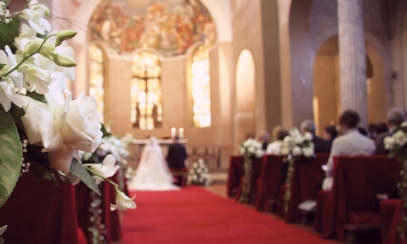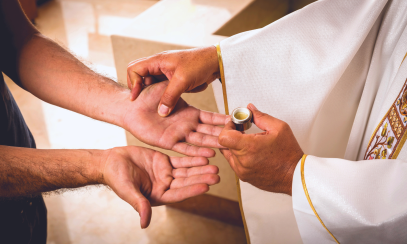
Living in Christ: Sacraments of the Catholic Church
The Church recognizes the existence of seven sacraments – outward and visible signs – instituted by Christ, to confer God’s inward and invisible grace. They are rites of initiation, healing and vocation. Regarding the sacraments, the USCCB explains it this way: “The visible reality we see in the sacraments is their outward expression, the form they take, and the way in which they are administered and received. The invisible reality we cannot ‘see’ is God's grace, his gracious initiative in redeeming us through the death and resurrection of his Son.”
The Church recognizes the existence of seven sacraments – outward and visible signs – instituted by Christ, to confer God’s inward and invisible grace. They are rites of initiation, healing and vocation. Regarding the sacraments, the USCCB explains it this way: “The visible reality we see in the sacraments is their outward expression, the form they take, and the way in which they are administered and received. The invisible reality we cannot ‘see’ is God's grace, his gracious initiative in redeeming us through the death and resurrection of his Son.”
Sacraments of the Catholic Church series
Baptism | Confirmation | Eucharist | Reconciliation | Anointing of the Sick | Matrimony | Holy Orders
Sacraments of Initiation
The sacraments of initiation “ground the common vocation of all Christ's disciples, a vocation to holiness and to the mission of evangelizing the world. They confer the graces needed for the life according to the Spirit during this life as pilgrims on the march towards the homeland.” (CCC 1533)
Baptism (from the Greek word baptisma, a “dipping”) is the sacrament in which, by water and the power of the Holy Spirit, a person is cleansed of all sin, including original sin, and experiences birth into the new life of Christ.
When a person is baptized…
- water is poured over their head (or they are immersed in water)
- the minister of the sacrament says the words: “I baptize you in the name of the Father, and of the Son, and of the Holy Spirit.”
The biblical basis for baptism is found in Matthew 28:19:
"Go, therefore, and make disciples of all nations, baptizing them in the name of the Father, and of the Son, and of the holy Spirit."
Confirmation is the sacrament in which the baptized are strengthened by the Holy Spirit in order to bear witness to Christ and prepare to take on the role of a disciple.
When a person is confirmed…
- a priest or bishop will lay their hands on them
- the priest anoints the person’s forehead with chrism oil
- the priest pronounces the words, “Be sealed with the Gift of the Holy Spirit.”
The biblical basis for confirmation is found in Acts 8:14-16a, 17:
“Now when the apostles in Jerusalem heard that Samaria had accepted the word of God, they sent them Peter and John, who went down and prayed for them, that they might receive the holy Spirit, for it had not yet fallen upon any of them; they had only been baptized in the name of the Lord Jesus. Then they laid hands on them and they received the holy Spirit.”
Eucharist (from the Greek word eucharistia, “thankfulness”) is the sacrament in which the true Body and Blood of Christ, who is truly and substantially present under the appearance of bread and wine, is received in holy Communion.
When the Eucharist is celebrated…
- the priest consecrates the bread and wine during the Holy Mass
- the priest then pronounces the words of institution that memorialize Christ’s pronouncement at the Last Supper: “This is my body … This is my blood.”
The biblical basis for the Eucharist is found in Luke 22:19:
“Then he took the bread, said the blessing, broke it, and gave it to them, saying, ‘This is my body, which will be given for you; do this in memory of me.’”
Sacraments of Healing
“The Lord Jesus Christ, physician of our souls and bodies, who forgave the sins of the paralytic and restored him to bodily health, has willed that his Church continue, in the power of the Holy Spirit, his work of healing and salvation, even among her own members. This is the purpose of the two sacraments of healing: the sacrament of Penance and the sacrament of Anointing of the Sick.” (CCC 1421)
Reconciliation (or penance, confession) is the sacrament in which sins committed after baptism are confessed after an examination of conscience and forgiven by a priest in the name of Christ.
When someone seeks reconciliation…
- the penitent will verbally confess their sins to a priest
- the priest grants absolution with the words, “I absolve you from your sins in the name of the Father, and of the Son, and of the Holy Spirit. Amen.”
The biblical basis for reconciliation is found in John 20:21-23:
“[Jesus] said to them again, ‘Peace be with you. As the Father has sent me, so I send you.’ And when he had said this, he breathed on them and said to them, ‘Receive the holy Spirit. Whose sins you forgive are forgiven them, and whose sins you retain are retained.’”
Anointing of the Sick is the sacrament in which those who are ill are anointed to impart spiritual strength and physical healing.
When someone receives the anointing of the sick…
- the priest anoints the sick with blessed oil
- the sick person is blessed by the priest with the words, “Through this holy anointing may the Lord in his love and mercy help you with the grace of the Holy Spirit. May the Lord, who frees you from sin save you and raise you up.”
The biblical basis for anointing of the sick is found in James 5:14-15:
“Is anyone among you sick? He should summon the presbyters of the church, and they should pray over him and anoint [him] with oil in the name of the Lord, and the prayer of faith will save the sick person, and the Lord will raise him up. If he has committed any sins, he will be forgiven.”
Sacraments of Vocation
Marriage and holy orders are sacraments “directed towards the salvation of others” that “confer a particular mission in the Church and serve to build up the People of God.” (CCC 1534)
The sacrament of Matrimony signifies the union and love that exist between Christ and the Church. It is a faithful covenant in which a man and a woman unite in such a way that, by forming “one flesh,” they can transmit human life. As spouses and parents, men and women cooperate in a unique way in the Creator’s work.
When a man and a woman celebrate the sacrament of marriage…
- a man and woman approach the priest with mutual consent to live together as husband and wife
- the couples exchange vows.
The biblical basis for marriage is found in Mark 10:6-9:
“But from the beginning of creation, ‘God made them male and female. For this reason a man shall leave his father and mother [and be joined to his wife], and the two shall become one flesh.’ So they are no longer two but one flesh. Therefore what God has joined together, no human being must separate.”
Holy Orders is the sacrament in which a bishop confers on a baptized man the grace of the Holy Spirit and sacred power for the service of the faithful. It can be administered in three forms: deacon, priest and bishop.
When a man is ordained…
- the bishop lays hands upon him
- the bishop prays the prayer of consecration over him.
The biblical basis for holy orders is found in three different passages for each level of holy orders:
Deacon in 1 Timothy 3:8a-9,13: “Similarly, deacons must be dignified, not deceitful, not addicted to drink, not greedy for sordid gain, holding fast to the mystery of the faith with a clear conscience. Thus those who serve well as deacons gain good standing and much confidence in their faith in Christ Jesus.”
Priest in Acts 14:23: “They appointed presbyters for them in each church and, with prayer and fasting, commended them to the Lord in whom they had put their faith.”
Bishop in Titus 1:7a-8, 9a: “For a bishop as God’s steward must be blameless, not arrogant, not irritable, not a drunkard, not aggressive, not greedy for sordid gain, but hospitable, a lover of goodness, temperate, just, holy, and self-controlled, holding fast to the true message as taught so that he will be able both to exhort with sound doctrine and to refute opponents.”



